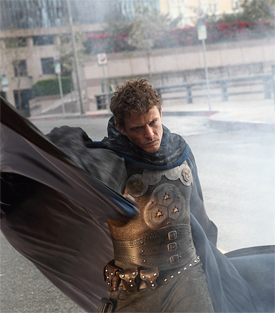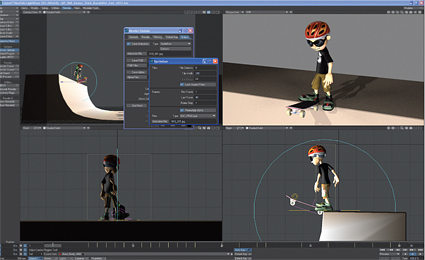Using LightWave 10: Cool Software, Cool Price

Remember the splash at NAB1990 when NewTek brought out the Video Toaster with LightWave animation software running on the Amiga platform? Things have come a long way since then.
The latest Version 10 of a whole series of evolutions called "LightWave 3D" packs a wallop of features for its price (new, $895; upgrades, $495) and is already being used by some creative visual effects artists on some pretty cool projects.
"The greatest improvement in this new release is its ability to help computer artists and graphic designers make iterative changes in real time," explained Rob Powers, vice president of 3D development at NewTek. "It gives them interactive control over their creations, and this type of workflow was used extensively by James Cameron to visualize the scenes on Pandora for 'Avatar,' among many other projects. If film artists and game creators can see their changes in real time, their work can keep up with their imaginations."
CORE TECHNOLOGY

This on-air Promo from "The Cape" picturing David Lyons, was created using LightWave 10. Credit: Justin Lubin/NBC You can see all of the new features of LightWave 10 on NewTek's website, including a newly enhanced Modeler program and Layout, which incorporates many elements of LightWave CORE technology based on an object-oriented, parametric node-based architecture.
"Our CORE architecture is behind a lot of the advancements in the LightWave 10 release," Powers said. "Its python-based expressions and scripting capability is a next-generation 3D software that supports our implementation of the Bullet Dynamics open-source physics engine originally authored by Erwin Coumans. You saw its full glory when Digital Domain used it to destroy Los Angeles in '2012' or in the pit fighting sequence created by Framestore for the recent 'Sherlock Holmes' movie."
The new LightWave 10 software also includes time remapping tools, which Powers used to duplicate the swim cycle of the 'Spork' creature under the ice caps of Europa in Cameron's "Aliens of the Deep," released in IMAX 3D.
"With the new stereoscopic 3D convergence rig we have implemented in this latest LightWave release, you can adjust the zero parallax point in a way similar to Vince Pace's Fusion 3D physical camera adjustments," Powers said. "It lets you dynamically track the inter-ocular distance throughout a shot, and in a future release we will be adding inter-axial control."
If you saw the Jan. 9 premiere of NBC's new series, "The Cape," a BermanBraun production from executive producer/creator Tom Wheeler, you witnessed LightWave 10 in action.

The 3D artists at FunGoPlay took advantage of LightWave 10's VPR and SpriteGen features as seen in this animation scene. The superhero star of the show, Vince Faraday (David Lyons) has been taught by the ringleader of a circus crime gang, Max Malini (Keith David) to wield his mantle made of indestructible spider silk as an extension of his fighting powers to battle the arch villain Chess (Peter Fleming) in a style reminiscent of Indiana Jones's whip or an updated version of Lash LaRue.
Most of these effects in the show's pilot were created at Santa Monica's Eden FX facility using a pipeline created by Eden's lead VFX artist, Stefan Bredereck, based on NewTek's LightWave 10.
"I was given roto animation plates of the cape along with depth information from a second 'witness' camera," Bredereck said, "and imported it into LightWave 10 as vision motion capture where I could craft its motions. This was exported to Softimage XSI for the cloth simulation, then brought back into LightWave 10 to render with a node-based bluish-velvet cape shading system that I developed."
"We had the creative advantage that nobody really knows what a spider silk cape would actually look like, so we took maximum advantage of LightWave 10's colorization controls."
VIEWPORT PREVIEW RENDERER
But one of the most unique projects that LightWave 10 has been used to create is the collaborative online game-playing system from FunGoPlay that expands the notion of computer games into physical activity in the outside world.

FunGoPlay is a massive undertaking that has required all of Vaughan's extensive VFX creation experience. As William Vaughan, animation director at FunGoPlay, explained it, "This is a new concept in online gaming where kids ages 6-11 get points controlling their artificial characters in computer space, and then use real-life gaming equipment like soccer balls and footballs containing microchips, that has been created in partnership with EB Brands to gain additional points playing outside with members of their own social network."
FunGoPlay is a massive undertaking that has required all of Vaughan's extensive VFX creation experience.
"For us, the biggest advantage of LightWave 10 is its real-time Viewport Preview Renderer [VPR] directly in the ViewPort Window," Vaughan said. "I see this as the best evolution of LightWave 3D because it lets you see how your final render will look like as an interactive preview in any ViewPort on the screen. It has sped up our whole team's learning curve creating this virtual world."
Phase one of the FunGoPlay game world should be online this summer, with phase two to follow soon. Check it out at www.fungoplay.com.
Jay Ankeney is a freelance editor and post-production consultant based in Los Angeles. He can be contacted at JayAnkeney@mac.com.
Get the TV Tech Newsletter
The professional video industry's #1 source for news, trends and product and tech information. Sign up below.
